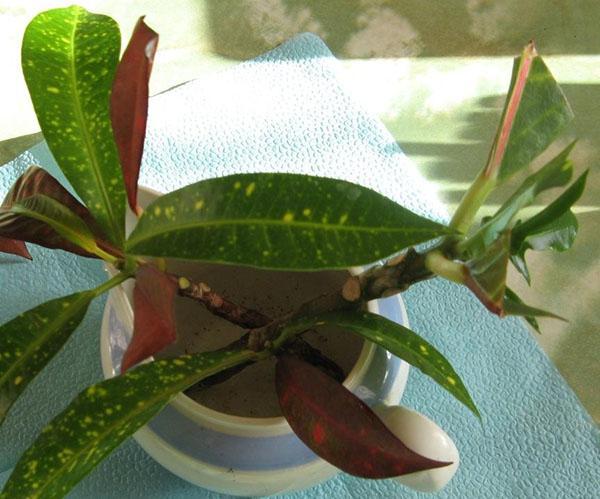Croton propagation: an overview of two different ways
 Croton breeding is a wonderful opportunity to expand your greenhouse. Since the houseplant has the fame of a capricious flower, it is necessary to choose the most suitable method for dividing it. As a result, the culture will not only take root well in a new place, but will surprise its owner for many years.
Croton breeding is a wonderful opportunity to expand your greenhouse. Since the houseplant has the fame of a capricious flower, it is necessary to choose the most suitable method for dividing it. As a result, the culture will not only take root well in a new place, but will surprise its owner for many years.
Croton propagation by cuttings
It turns out that even such a familiar process has two different approaches. They consist in the fact that the cuttings in one case are dipped into water, and in the other, they are stuck into the prepared substrate. Nevertheless, when carrying out both procedures, it is recommended to observe the following formalities:
- sprinkle the edge of the stem root (or dip the stem in a solution) to stimulate root formation;
- remove the lower leaves;
- spill the soil with water;
- Cover each container on top with a plastic bag and fix with an elastic band.
Cutting off the shoots from an adult plant, the cut is made (obliquely) with a sharp blade so that there are no torn tissues. Otherwise, they will be like an Achilles' heel. Fungal, viral and bacterial microorganisms most often penetrate through these tissues.
Many growers carry out croton breeding in the winter. It is worth remembering that codiaeum does not tolerate hypothermia of the soil. Therefore, it is not advisable to put the pot on the windowsill. They also try to maintain the temperature within 23-25 ° C. Periodically, the greenhouse is removed and the flower is sprayed, regardless of the method of cuttings.
Experiment Results
A month later, the following picture can be observed. The specimen, planted in the ground, activated the buds: 2 main ones blossomed, and 5 simply swelled. The one that was placed in the water sprouted up to 1 cm, which serves as a signal for landing in the ground.
The maximum root length for transplanting is 2 to 3 cm. Do not wait until they become larger. Water does not contain the required amount of nutrients.
When croton is propagated, the soil is chosen textured. Mix sand and deciduous / sod soil (1 part each). Charcoal is added as an antibacterial component. At the bottom of the pot, drainage from the bark of oak or expanded clay is laid out. In this case, the seedling needs:
- abundant watering;
- air humidification;
- diffused lighting.
Yet, until its root system has grown stronger, the flowerpot is covered with a plastic bag, creating greenhouse conditions for the plant. Periodically, the canopy is removed to spray the foliage.
But to make a tree in the shape of a trunk, you can pinch off its top. Now the main thing is to provide the codiaum with the climatic conditions of the tropics. The results of the experiment show that rooting takes place in any case, but only at different rates.